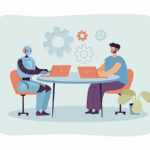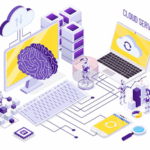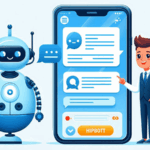Dominate 2025 with Next-Gen AI and ML Services for Future-Ready Growth
August 7, 2025 | 0 Comments
business@elyriasoft.com |
+1-469-772-0531
 USA
USA IN
IN
 SG
SG
 PT
PT
The application development has gone through various changes till now and is still evolving as time changes. Each phase brought some improvements and came up with its own challenges. However, to overcome the challenges faced with traditional models, some expert and skilled developers came together and established an approach called Agile methodology. This approach addressed the issues, such as limited customer involvement, lack of adaptability, and rigid requirements that came up with traditional models. Later, the development became more streamlined with the introduction of containers and microservices, which fall under cloud native architecture practices. However, today, AI-powered cloud native application development has made the overall app development process even simpler by leveraging AI and ML capabilities with cloud native principles.
In this blog, we will explore the role of AI in modern cloud native application development and how AI enhances scalability, adaptability, and efficiency in the development process.
Cloud native refers to the method of developing and deploying applications in a cloud environment. Unlike traditional applications, cloud native approach breaks down the application components into easily managed modular services, leading to improved speed and enhanced scalability. Today, most businesses want apps that are highly scalable and can fulfill their frequent requirements changes to match their customer’ needs. Therefore, it has become essential for cloud based application development companies to adapt to AI-powered solutions designed to seamlessly enable application development in cloud environments.
Cloud native applications are built by combining several small and interconnected components together known as microservices, that run on a cloud computing environment. As the components are independent, they can be easily modified without affecting the other components of the application. Technologies such as microservices, containers, and CI/CD are used to build such applications. This leads to making the overall applications more scalable, reliable, and flexible.
Below, we have listed the differences between traditional, cloud based application development and cloud native application development in detail:
| Features | Traditional App Development | Cloud Based App Development | Cloud native app development |
| Definition | Traditional app development is the process of developing apps using traditional methodologies such as the waterfall model. | Cloud based application development refers to the process of developing applications that can run on cloud environments instead of entirely running on local servers and devices. | Have a monolithic architecture with some cloud integration |
| Hosting Environment | They are fully automated with CI/CD pipelines | Cloud-based apps primarily run on cloud servers but may have some local components for functionality or access. | Cloud native apps are specifically optimized to run on cloud environments. |
| Architecture | These applications run in a mainframe environment. | Follows monolithic architecture where each component is tightly coupled with the other. | Utilizes microservices and containers where components are loosely coupled. |
| Scalability | Less scalable and often requires extra physical resources to expand. | More scalable as compared to traditional apps. | Highly scalable. |
| Deployment | Needs to be done manually and takes time. | Can be partially automated | It might be more costly than cloud native as you need to reserve resources in advance, which can lead to wastage of money if not utilized fully. |
| Performance | Depends on local server capacity | Improved with cloud resources | Optimized with AI, auto-scaling, and distributed resources |
| Cost Structure | You will have to only pay for those resources that you have actually used. | Costly as we need to install additional physical resources if the requirement expands | You will have to only pay for those resources which you have actually used. |
| Examples | Legacy ERP systems, desktop software | SaaS apps hosted on a single cloud server | Netflix, Uber, Spotify |
We all know that the existence of cloud native application development has come up with several advantages. Despite having several advantages, there are still some challenges that need to be conquered. Here we have listed a few challenges that come along with cloud native app development:
Distributed Architecture: Cloud native apps utilize microservices and containers to develop the whole app. This distributed architecture makes it difficult for cloud developers to secure the entire system.
Expanded Attack Surface: Utilizing containerized deployments and APIs makes it easy for attackers to access the data.
Fast-Paced Development: The fast release cycles of cloud-native development may inadvertently introduce security loopholes in the code.
Although these challenges initially appear significant, AI-powered solutions provide an effective way to strengthen cloud application development services.
Conventional security solutions typically depend on rule-based mechanisms, which makes it difficult to keep up with the ever-evolving threats. Whereas AI-driven security provides a smarter, adaptive, and proactive process. Here is how AI is reshaping the cloud native development future by overcoming the challenges faced during cloud native application development:
AI has the capability to scan extensive network traffic, application logs, and user activity to identify unusual activity and patterns that help in identifying security threats. Not only this, AI can also detect noticeable risks that are usually not easy to find and often overlooked by humans.
AI enables businesses to continuously monitor the progress of cloud native applications, allowing them to quickly notice any suspicious activities. Detecting any suspicious activities in early stages allows organizations to respond quickly and minimize the potential impact that could lead to spending a large amount of cost.
Artificial intelligence has the capabilities to automatically respond to threat detection and make intelligent decisions. AI can block harmful requests, isolate affected containers, and automatically start fixes.
AI integrated with cloud services is transforming how organizations protect their cloud native apps with their AI-driven security solutions. Businesses now can gain real-time threat monitoring, automated responses to incidents, and predictive capabilities to identify and stop breaches before they happen. Here’s how AI plays a key role in transforming the cloud‑native app development process:
AI introduces strong automation to cloud-native application development. With technologies such as machine learning, it is able to manage repetitive tasks throughout the development cycle. Right from coding and testing to deploying patches, AI is capable of managing everything. This accelerates a lot of the processes such as debugging, discovering performance issues, and smoother releasing. This saves time and allows developers to put their energy into innovation rather than being bogged down by tasks that can be repetitive.
AI strengths in handling immense amounts of historical data allow developers to base their decisions on forecasts of possible risks that may come with each trend. This assists in making informed decisions for application design, resource allocation, and scalability planning. For instance, AI can predict traffic surges in cloud environments, enabling teams to pre-identify resources needed to avoid interruption.
With its ability to analyse user preferences and behaviour, AI delivers personalized and engaging experiences to its users to improve the overall user experience. You can take an example of Flipkart, where, while buying any product, the platform will automatically suggest some other products, titled as “frequently bought together”, based on your purchasing and search history. This increases the chances of users buying more products. However, in cloud native app development, it goes beyond just recommendations and suggestions. It can refine the app interface, adjust performance, and dynamically respond to changing conditions, delivering an interactive and seamless experience.
AI enhances the cloud infrastructure optimization process by dynamically managing the core resources such as processing capacity, data storage, and network connectivity that not only improve performance but also save cost. By leveraging AI capabilities such as advanced machine learning techniques and intelligent learning systems, AI can efficiently allocate resources in real time. This automation not only minimizes the cost spent on cloud infrastructure optimization but also enhances the overall performance.
Security is one of the major issues when we talk about cloud native applications. AI integrated with the cloud plays a key role in enhancing the safety measures by implementing advanced detection techniques. By leveraging its machine learning capabilities, AI can automatically respond to possible security risks and spot irregular patterns that can lead to unauthorized access.
Recent Posts

Dominate 2025 with Next-Gen AI and ML Services for Future-Ready Growth
August 7, 2025 | 0 Comments

Scale Smarter in 2025: Why AI-Powered Cloud-Native Application Development is the Future
August 7, 2025 | 0 Comments

Your 2025 Guide to Next-Gen AI Development for Smarter Business Solutions
August 4, 2025 | 0 Comments

How to Create Cutting-Edge Blockchain Apps: A 2025 Development Guide
July 31, 2025 | 0 Comments

Boost Your Brand with Custom Mobile App Development Solutions
July 25, 2025 | 0 Comments

No Leads, No Sales? Here’s Why Your Website Isn’t Converting — and How to Fix It
July 24, 2025 | 0 Comments
Categories

We will zealously try to help you by providing technical support. We are open to inquiries or requests.
business@elyriasoft.com
1910 Pacific Ave, Suite 2000 #2026, Dallas, TX 75201, US.
We are available for a friendly chat to discuss your business needs, no obligation.